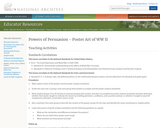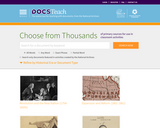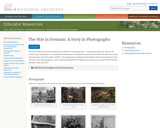
Poster circulated in Philadelphia in 1839 to discourage the coming of the railroad, 1839
- Subject:
- History
- U.S. History
- Material Type:
- Diagram/Illustration
- Primary Source
- Provider:
- National Archives and Records Administration
- Date Added:
- 02/04/2020

Poster circulated in Philadelphia in 1839 to discourage the coming of the railroad, 1839

This site provides a standards-based lesson on how the use of posters during WWII helped win over the hearts and minds of the American people.

Examine a collection of primary source documents about airplanes in the United States.

Examine a collection of primary source documents about automobiles in American history.

Examine a collection of primary source documents about highways in the United States.

Examine a collection of primary source documents of drawings created for patents.

Examine a collection of primary source documents about railroads in the United States.

Examine a collection of primary source documents about traffic in American history.

Examine a collection of primary source documents about trolleys and streetcars in American history.

Examine a collection of primary source documents about the Wright Brothers.

This lesson plan includes documents and images for learning about the American Revolution, the Constitution, the creation of the U.S. Navy, Eli Whitney's patent for the cotton gin, Thomas Cooper's violation of the Sedition Act, and the Electoral College.

This lesson examines Native American sovereignty and the Constitutional power granted to the president and the Senate to make treaties with foreign nations. The site presents the Treaty and related documents, including a photograph of the Indian leader, Spotted Tail. Explanatory text, materials for teachers, and links to further resources accompany the documents.

This section contains reproducible copies of primary documents from the holdings of the National Archives of the United States, teaching activities correlated to the National History Standards and National Standards for Civics and Government and cross-curricular connections.

This lesson presents documents pertaining to the treaty that brought an official end to the Mexican-American War. Materials for teachers and links to other resources accompany the documents.

This is a self-service online workshop for teachers who use primary documents to help students see the impact and ongoing relevance of the Constitution. It requires little advance preparation and provides everything needed, including a vocabulary list, document analysis worksheets, and historical documents -- John Marshall's Supreme Court nomination (1801), proclamation to New Orleans (1803), Lincoln's telegram to Grant (1864), Johnson oath photo (1963), and more.

View of Ohio tourists having early breakfast on parking Area 460 to 463 taken 07/21/1941,

The war in Vietnam has been described as the war America watched from their living rooms. Images of combat and American GIs were projected through our TV screens and across our newspapers daily. During the war in Vietnam, the American military gave the press unprecedented freedom of access to combat zones. This allowed newspaper reporters and photographers and television crews to document a war involving American sons and daughters on the other side of the world. This willingness to allow documentation of the war was also extended to the military's own photographers. Between 1962 and 1975, military photographers for the United States Army, Marine Corps, Navy, and Air Force took millions of photographs of the American conflict in Vietnam. Almost a quarter of a million of these images are now located at the National Archives. These photographs serve publishers, historians, and students who want to learn more about Vietnam. They include images of almost every aspect of the war.